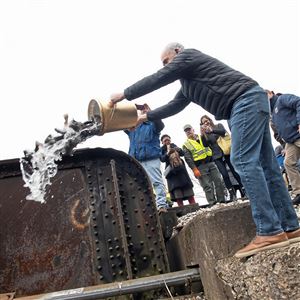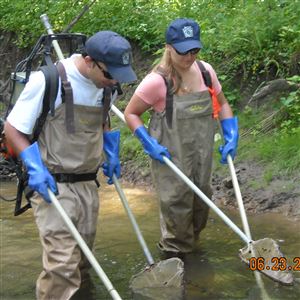Nearly $245 million worth of federal conservation grants is flowing into abandoned mines in Pennsylvania.
It’s from a program designed to filter the toxics out of billions of gallons of water draining from abandoned coal tunnels before it can pour into state waterways.
Communities and conservation organizations generally run the cleanup projects with much heavy lifting outsourced to contractors.
But some Pennsylvania groups have been cautious about applying for the money — a state law that protects conservationists attempting to clean discharge from abandoned mines leaves them vulnerable to civil lawsuits, they say.
The Pennsylvania Environmental Good Samaritan Act, the only state law of its kind in the nation, protects landowners and volunteer conservation groups attempting to clean abandoned mine discharges. A report published by Utah State University in 2022 said the Pennsylvania law, passed in 1999, had shown limited success.
“... The state has seen the condition of its streams and waterways improve,” wrote author Joe Davis. “In the first 20 years of the program, over 80 different projects were completed involving 44 different groups and individuals.”
But conservation groups say the state law includes exemptions that could expose participants to potentially costly civil lawsuits.
“The Environmental Good Samaritan Act does not apply to federal law," said a spokeswoman for the state Department of Environmental Protection. "It's important to note, while DEP determines project eligibility under the Act, DEP does not have the authority to make legal rulings on who receives protections from liability. That issue must be resolved in civil court.”
The Act specifies that groups and individuals may challenge the effectiveness of pollution remediation projects, holding conservation groups to the federal standard of cleanliness in civil litigation.
“In many cases, the impacted water bodies may never fully meet water quality standards, regardless of how much cleanup or remediation is done,” said the Utah State report. “By holding Good Samaritans accountable to the same cleanup standards as polluters or requiring strict compliance with the highest water quality standards, we have created a strong disincentive to voluntary cleanups.”
Chris Wood, CEO and president of Trout Unlimited, a nonprofit cool-water advocacy organization with chapters in Pennsylvania, said some conservationists consider the liability too great to get involved.
The presence of naturally reproducing wild trout is an indicator of water quality — the delicate fish can’t live in water tainted by mine drainage. Trout Unlimited provides pro bono conservation and technical advice to projects receiving the conservation grants.
“There are thousands of communities in Pennsylvania that have orange streams flowing through their backyards,” said Mr. Wood. “We know some groups would like to [build settling ponds and] clean up their streams, but it’s too much of a risk. It could ruin them if the project doesn’t live up to expectations.
“The dirty little secret that we’re all afraid of is that someone could say, ‘I know you have a permit under the Good Samaritan Law, but the water isn’t as clean as the Clean Water Act requires, so we’re going to sue you to clean it.’ Governments aren’t likely to complain if [the water quality] comes close, but other groups and even individuals could take you to court.”
Traditional coal mining exposes sulfur-bearing minerals to atmospheric oxygen and water. Often the resulting reactions form sulfuric acid and dissolved iron and release additional heavy metals. The mines fill with water that absorbs the toxic chemicals, seeping through fissures, corrupting ground water and flowing through unsealed mine entrances into surface water.
In the past, when a mine was played out, laws didn’t hold companies responsible for the holes they left in the ground. In Pennsylvania, thousands of miles of abandoned mines are legally owned by no one.
A 2022 water quality report from the DEP cited acidic drainage from abandoned mines as the largest source of stream pollution in Pennsylvania. Forty-three of the state’s 67 counties, including Allegheny, account for a third of America’s abandoned mine lands, said the report.
Typically, federal funding for mine mitigation is allocated to the states, which direct it to municipalities, institutions and nongovernmental organizations.
In most cases, the funding pays for construction and upkeep of remediation projects, mostly passive settling ponds that filter out toxins near points where drainages emerge.
For years, Pennsylvania could count on $65.5 million a year in federal funding for mine drainage projects. In 2021, Congress approved a $550 billion federal infrastructure package that earmarked more than $11 billion for the national Abandoned Mine Land Reclamation Program.
In 2022, Pennsylvania’s mine mitigation grants spiked to nearly $245 million a year, substantially more than any other state. West Virginia, the next-largest beneficiary, gets about $141 million a year. In 15 years, Pennsylvania is expected to accrue more than $3.7 billion for mine remediation.
“That’s terrific, long overdue. A big shot in the arm,” said Trout Unlimited’s Mr. Wood.
But the windfall is the result of a dark history. Coal mining in Pennsylvania began in the mid-1700s to support the colonial iron industry. By the 1800s underground anthracite and bituminous operations in the commonwealth fueled the industrial growth of the expanding nation and provided the primary fuel source for Western Pennsylvania's growing steel industry.
Practically unregulated mining powered America through two world wars and generally continued until 1977, when modern mining laws forced changes in the industry.
Nevertheless, the funding bonanza compensates for a small portion of past environmental abuses and current challenges, Mr. Wood said.
Mine discharge rendered some streams and rivers lifeless, practically devoid of plants, insects and other aquatic species. Although cleanup efforts originated decades ago, some Pennsylvania waterways have flowed orange for most of the past century. Beneath the surface, Pennsylvania is honeycombed with thousands of miles of abandoned and flooded coal tunnels.
Research at Millersville University, updated in 2022, documented 11,249 known abandoned mines in the state. The study found 6,651 impacting the environment and 3,276 presenting health and safety impacts.
Statewide 141 are categorized as threatening “extreme health and safety impacts” and of those, 26 are in Allegheny County. At least two pass beneath Pittsburgh.
Despite the reluctance of some groups to pursue remediation programs, passive settling ponds are in operation throughout the state.
Trout Unlimited is partnered with a coalition of organizations and communities running remediation projects impacting part of the Susquehanna River, which starts in New York and weaves through Central Pennsylvania, comprising 43% of the Chesapeake Bay watershed.
The Trout Unlimited projects filter outflow from abandoned mines fouling the West Branch Susquehanna River, the Susquehanna’s largest feeder.
The river drains about 7,000 square miles in six counties from its confluence with the mainstem in Northumberland County, 50 miles north of Harrisburg, westward to tributaries stretching into northern Indiana County.
The Utah State report said that in 1972, the West Branch was so acidic it was uninhabitable to most fish. By 2009, volunteer conservation groups had reversed acidity to healthy levels, and fish species in the river had increased by 3,000%
“In the middle of West Bank Susquehanna there’s an area called Kettle Creek,” said Mr. Wood “There were about nine miles that were lifeless for 100 years. We now have, because of the cleanups we’ve done, nine miles of naturally reproducing native brook trout.”
Other projects are underway. In Clinton and Centre counties, acidity from bituminous mines has made Beech Creek uninhabitable. Mr. Wood said a workgroup is laying the operational foundation to return a functional fishery to the creek.
Orange water flowing from abandoned mines is visible throughout the Ohio River watershed.
In September, the DEP announced $38.76 million in funding for six restoration projects on abandoned mine lands. Most of those waterways flow east.
But on one of the streams, Shade Creek in Somerset County, plans call for an onsite treatment plant to funnel water through neutralizing materials and dispose of sludge through a discharge conveyance plan. The project will replace largely ineffective passive settling pools before the dead stream enters Stonycreek River. Its waters flow through several rivers before meeting the Allegheny River near Freeport.
Many Allegheny County waterways remain fouled by mine drainage.
On the Allegheny-Westmoreland county line, a stream once derisively called Sulfur Creek was partially remediated by the early 1980s. Turtle Creek, which enters the Monongahela River near what is now Kennywood Park, has been stocked with state-raised hatchery trout through a 3.9-mile stretch after a mine opening was sealed decades ago. In periods of heavy rain, however, discharge still spills into the stream, rendering it unable to support a fishery for months. Another mine tunnel empties into Brush Creek, which enters Turtle Creek at Trafford, turning the water orange and mostly lifeless.
The Red Waterfall at milepost 119 on the popular Great Allegheny Passage trail is also on the county line on the Youghiogheny River. The waterfall drains out of a long abandoned mine and down a steep hillside, its water flowing under the trail and into the Yough. About 1½ miles upstream at Sutersville, the trail goes over an orange tributary, Gillespie Run, which is polluted by the same abandoned mine. The river dilutes the pollution and has a healthy fish population all the way to its confluence with the Monongahela at McKeesport.
Mr. Wood said funding for abatement of mine drainage could be steered to more conservation groups if organizers felt it was safer to get involved. A bill working its way through Congress could potentially do that.
“The Community Reclamation Partnership Act … would create a federal program that would basically make what Pennsylvania’s Good Samaritan law does extant across the landscape,” he said. “It would say groups and individuals can’t be sued if their projects clean [abandoned mine drainage] but not enough to meet to Clean Water Act standards.”
As written, the act does not protect groups that are grossly negligent, their projects making things worse.
“But the [federal bill] would protect people who get a permit and do exactly what they said they would do even if they came in a little bit under federal Clean Water Act standards,” said Mr. Wood. “We’re just trying to make sure we don’t let the perfect be the enemy of the good.”
A similar bill would provide legal protection to hard rock mine projects in Western states.
They are unusual bills, said Mr. Wood, because no one is presenting two sides to the debate.
“There’s no boogeyman here. There is no constituency for abandoned mine drainage,” he said. “Democrat, Republican ... everybody cares about clean water. It’s the liability exposure that is the challenge.”
John Hayes: jhayes@post-gazette.com
First Published: November 19, 2023, 10:30 a.m.
Updated: November 20, 2023, 8:14 p.m.






















